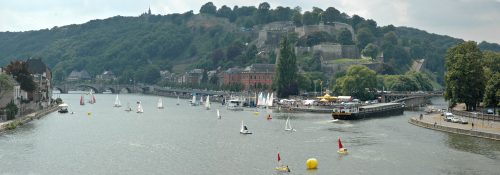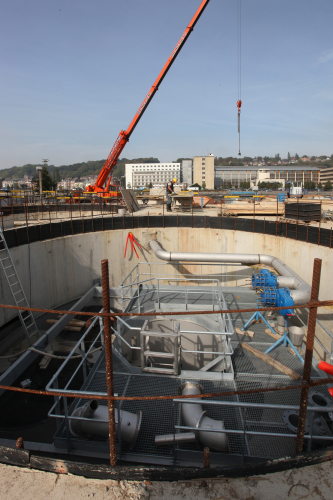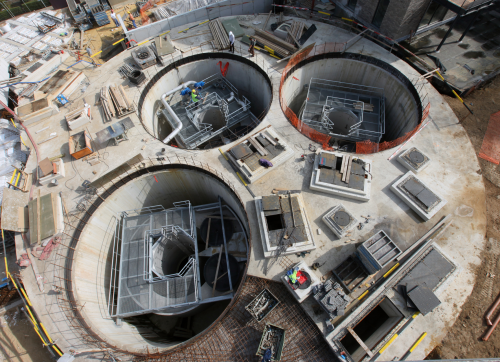


Strategically situated on the confluence of two navigable rivers, the Meuse and the Sambre, the ancient city of Namur has made history many times over from Celtic through to modern times. Now a densely populated conurbation nestled in the narrow valley of the River Meuse, its rich architecture and archaeology are a testament to its colourful past.
But in recent times, it is a historic vision for improved river quality which has focused the attention of the 125,000 inhabitants on a huge undertaking. It has seen the town under siege from construction works during the past four years. The solution has halted the routine discharge of sewage into the rivers via more than 50 different Combined Sewer Outfalls and stopped the region from severely lagging behind European water quality targets.
Long planned treatment
The first proposal to build a new sewage treatment works for Namur and its surrounding towns was put forward more than 35 years ago. The opening of the new works at Brumagne in February 2011 was attended by the European Environment commissioner Janez Potocnik and Philippe Maystadt, president of the European Investment Bank, which has provided funding for the project. The ceremony celebrated an achievement which will mean the region’s water quality ambitions for the European Water Framework Directive (WFD) and now the Municipal Wastewater Directive are well on track for 2015 targets.
The road to completion saw the formation, along the way, of the Belgian Utility INASEP, to design and oversee the project, and local water company SPGE to finance the programme. Belgian contracting group CFE was awarded a main contract in 2007 to deliver the project.
The new sewage treatment works is 6km downstream from Namur at Brumagne and treats some 20,000 m3 of sewage a day. The plant meets the latest standards for solids and BOD removal from wastewater as well as the removal of nitrates, nitrites, ammonia and phosphorus. Two secondary municipal works upstream at Wepion and Floriffoux also form part of the system.
Wastewater under pressure
A major challenge for the project was how to convey wastewater for treatment to the new plant. The dense urban environment made localised wastewater treatment unfeasible, so a system of conveyance needed to be devised to connect the city’s combined sewers - some dating back to the 19th century - into an integrated network.
The new network intercepts wastewater from local neighbourhood combined sewers and redirects it towards the treatment works. To convey the sewage some 25km of new connecting pipeline have been retrofitted to the existing sewer networks.
A further challenge of the project was that, in the central part of the city, a combination of limited space, a complex underground maze of utilities and services, and the level topography meant the pipes could not be buried deeply underground. Instead, the network is operated under pumped pressure, with a total of 54 pumping stations which inject wastewater from neighbourhood main sewers into the collection network.
It is here that a central and critical element of the whole solution was devised to treat storm water overflows from Combined Sewer Outfalls. The frequent risk of overflow of the pumping stations during even light rainfall could have caused unwanted discharges into the river system.
Vortex solution
To combat this risk, the concept of using vortex technology was first considered as long ago as 1999 by Tractabel engineer Hugh McLachlan and then INASEP project engineer Marc Lemineur. The technology provided the method for holding back and treating storm water locally to avoid polluting waters entering the river system during peak flows.
So, vortex separation technology from Hydro International is being applied to control the flows and remove sediments and pollutants. The Hydro Storm King® is a hydrodynamic separator with an integral unique, non-powered, self-cleansing screen.
A total of 33 Hydro Storm Kings have been manufactured under licence from Hydro International by CFE and successfully installed. Ranging from 3-9 m in diameter they are spread between 37 of the pumping stations, with sites containing as many as three units treating up to 1300 l/s per site. Each unit is individually designed and sized to suit the flow and civil requirements of its location.
In particular, the devices prevent highly polluting sediments being re-suspended as a result of high volume ‘first flush’ flow from storm incidents from entering the river system. The Hydro Storm King units require no power and only operate during wet weather once the head of water reaches a pre-determined height to prevent discharge directly into the rivers. At lower flows, the water is channelled normally through the system.
Storm pollution prevention
The device screens gross solids and floatables greater than 6 mm in two directions, and pre-treats sediments, settleable solids and associated pollutants.
Pollutants collected at the base of the Hydro Storm King devices are re-introduced into the main sewers for eventual treatment at the Brumagne wastewater plant, in just the same process as in dry weather and low flows. Treated storm water overflow can safely be discharged via the CSO to the watercourse.
The Belgian utility INASEP is overseeing the project: “A major advantage of the Hydro units is that they operate as a decentralised system, each located close to the source of the wastewater,” said Marc Lemineur, the INASEP deputy director general who has been involved with the scheme throughout his career.
“The solution avoided building a large, central storm water treatment plant, saving cost and space. The Hydro storm water treatment devices also greatly reduce the flow requirements of the sewer network, saving both capital expenditure and reducing operating costs and pumping requirements.
“The alternatives to a decentralised CSO protection solution based on Hydro equipment were so unfeasible, potentially so much more costly and could not ensure better pollution prevention, that we did not even make a detailed evaluation of them; this solution is easily the best.”






